

Researchers demonstrate complete solar-powered hydrocarbon production. Ammonia - Green Ammonia - Ammonia for Power. Clouds Hill Imaging Ltd.Getty Images The Royal Society is promoting green ammonia in a new wide-ranging policy brief.Ammonia is used as a cleaning product, a dye and tanning agent, and industrial fertilizer.
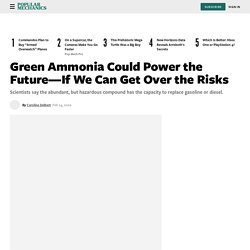
A Tiny Nuclear Plant Is Coming to Idaho. An innovative nuclear plant that runs on lower waste fuel hopes to be online by 2022-2025.The plant's creator, Oklo, joins startups around the world working to innovate safer, smaller nuclear power plants.But experts suggest that Oklo's timeline is unrealistic with years of nuclear approval process ahead.

An experimental nuclear reactor in Idaho could be the first of its kind in the United States: a commercial reactor providing power using fuel that reduces nuclear waste. The small power plant could power about 1,000 homes and can run almost autonomously for 20 years. This project comes from Oklo, that claims its reactor would be the “first ever” one to generate power through nuclear waste. This Marvelous Machine Splits Moon Dust Into Oxygen and Metal. Like the settlers of old, space explorers will live off the land.
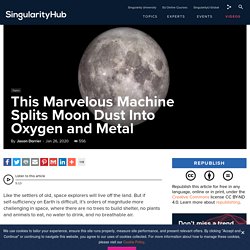
But if self-sufficiency on Earth is difficult, it’s orders of magnitude more challenging in space, where there are no trees to build shelter, no plants and animals to eat, no water to drink, and no breathable air. Like The Martian’s Mark Watney, future space explorers will have to use a heavy dose of science-y resourcefulness to survive hostile environments on the moon and Mars. Luckily, also like Mark Watney, they’ll have access to some of the brightest brains on the planet. Some of those brains, currently working at the European Space Agency, are making a machine that transmutes moon dust into oxygen—to breathe and make rocket fuel with—and metal for building. Moon Dust Is Nearly Half Oxygen Truly, the surface of the moon is a barren wasteland.
It’s this dust, fine, grey, and bone dry, that may prove to be an invaluable resource for lunar homesteaders. Sunlight turns plastic waste into key element of hydrogen fuel cells. Our plastic waste problem is a large one, and it’s only getting larger.
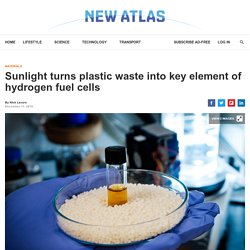
This is a huge environmental problem that requires some big picture thinking, but scientists are also exploring more subtle ways of chipping away at it and that includes turning plastic waste into sources of fuel. New research out of Singapore’s Nanyang Technological University (NTU) has thrown another interesting possibility into the mix, with scientists converting consumer plastic into a chemical used to to produce electricity in hydrogen fuel cells by exposing it to sunlight. The key to the breakthrough was the introduction of a new kind of photocatalyst, which is a material that harnesses light energy to power chemical reactions.
In search of new ways to convert plastic waste into useful chemicals, the NTU team turned to a type of affordable, biocompatible metal called vanadium. An 'Artificial Leaf' Turns Atmospheric Carbon Dioxide Into Fuel. A process like this is exciting for two reasons.

First of all, removing carbon dioxide (the primary contributor to global warming) from the atmosphere will help to slow climate change. Second, the resulting alternative fuels will allow for people to continue relying on non-electric automobiles, thus giving us more time to make the transition to carbon-neutral living. Or as Wu told Universe Today via email: "This technology is expected to reduce CO2 emission from oil companies, automobile companies, and steel companies. It can also provide clean and sustainable fuels, methanol, for vehicles and aircrafts. Rivers could generate thousands of nuclear power plants worth of energy, thanks to a new ‘blue’ membrane.
BOSTON—Green energy advocates may soon be turning blue.
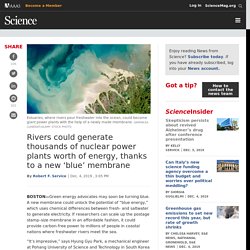
A new membrane could unlock the potential of “blue energy,” which uses chemical differences between fresh- and saltwater to generate electricity. If researchers can scale up the postage stamp–size membrane in an affordable fashion, it could provide carbon-free power to millions of people in coastal nations where freshwater rivers meet the sea. “It’s impressive,” says Hyung Gyu Park, a mechanical engineer at Pohang University of Science and Technology in South Korea who wasn’t involved with the work. “Our field has waited for this success for many years.” Blue energy’s promise stems from its scale: Rivers dump some 37,000 cubic kilometers of freshwater into the oceans every year. Series: Changing energy landscape for rural electric co-ops. "Electro-swing" battery captures CO2 from power plants or ambient air. Researchers at MIT have developed a new method for pulling carbon dioxide out of any passing gas stream – whether that’s a chimney flue at a power plant or even just ambient air.
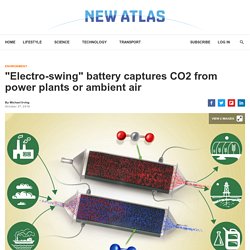
The new device is basically a specialized battery that can absorb carbon dioxide while it’s charging, then release it as a pure, steady stream for industrial use when discharging. Maxime louis-courcier uses paper clay to design household appliances. Through two new products, industrial designer maxime louis-courcier explores materials to propose a sustainable approach to household appliances. the project, which consists of the woven air-conditioner and the paper clay air humidifier, forgoes the use of electricity to provide functional objects designed for the home environment. the woven air-conditioner and the paper clay air humidifier all images and videos courtesy of maxime louis-courcier used during the summer, the woven air-conditioner by courcier is a low-tech version of an electric air-cooling system. as a tapestry, it’s as decorative as functional. its design highlights the use of phase change materials (PCM). they are bio-based fatty acids, that melt at a certain temperature and absorb heat while they’re melting. with its tubes filled of PCM, the object absorbs the heat in contact with the air and also creates a barrier to the heat that comes from outside through the walls.
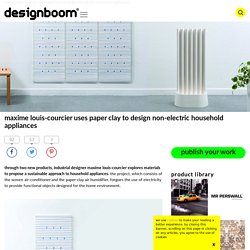
Molten Salt Reactor News and Advantages. Moltex Energy, a small British company, has raised millions of dollars through crowdfunding by pitching its new type of nuclear fission, which it calls a Stable Salt Reactor (SSR).
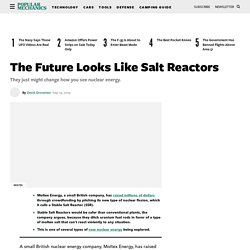
Stable Salt Reactors would be safer than conventional plants, the company argues, because they ditch uranium fuel rods in favor of a type of molten salt that can't react violently to any situation. This is one of several types of new nuclear energy being explored. Heat and carbon turn plastic waste into jet fuel. Thermal Battery Holds 1.2 Megawatt-Hours of Energy in a 20-Foot Box. "World's first working thermal battery" promises cheap, eco-friendly, grid-scalable energy storage. We've Found a New Source for Rare-Earth Elements We Need for Green Tech. Alternative Energy Technologies. Chemical conversion process gives plastic waste new life as fuel. Electricity-free air con: Thermoacoustic device turns waste heat into cold using no additional power. Carbon capture system turns CO2 into electricity and hydrogen fuel. Pocket-Size Nuclear Free Energy is Almost Here! After the groundbreaking announcement of an industrial method to transmute elements into gold and silver, or any materials for that matter, in 2016 [here], Russian scientists have been pushing the boundaries of nuclear miniaturization in the last few years by designing, and recently by successfully producing a pocket-sized nuclear battery that can power portable devices for decades without recharging, with as much as 10 times the energy capacity of its predecessor!
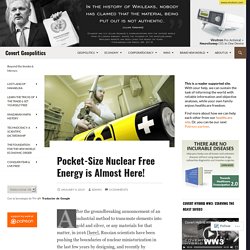
According to a recent publication by the Nuclear Engineering International, Advances in nuclear engineering have enabled the release of safer designs that prevent runaway nuclear radioactivity. The nuclear fission-fusion hybrid emits no nuclear radiation at all, as the system itself converts radioactivity back to usable energy in real time. This particular project was inaugurated in about the same time when we started hearing from Putin to “dump the dollar”,
Largest ever continuous oil and gas resource found in the United States. Recyclable wonder-fuel promises twice the range and zero emissions at half the price. Artificial photosynthesis breakthrough could turn CO2 into plastics on the cheap. Los Alamos startup begins sales of greenhouse product. ALBUQUERQUE, N.M. — Greenhouse growers can now bathe their crops in yield-boosting, late-summer-like sun rays all year round courtesy of Los Alamos startup Ubiquitous Quantum Dots. UbiQD Inc. launched commercial sales of its red-light emitting window film for the first time this week, marking a major milestone for the 4-year-old company, and possibly a ground-breaking advance for greenhouse production. The company says its film can boost crop yields by 10 percent or more by using quantum dots that shift sunshine into a red-light-emitting spectrum that mimics late-summer sun year-round.
That’s considered the most potent time of year for plants because they sense winter coming and grow faster, said UbiQD CEO Hunter McDaniel. “We’ve been testing it in greenhouses in commercial settings for about a year and a half now,” McDaniel said. “We’ve seen yield improvements in excess of 10 percent in numerous crops.” “You just string it up under any existing structure,” McDaniel said. The U.S. Texas is about to create OPEC's worst nightmare. Photographer: Callaghan O'Hare/Bloomberg The map lays out OPEC’s nightmare in graphic form. An infestation of dots, thousands of them, represent oil wells in the Permian basin of West Texas and a slice of New Mexico. In less than a decade, U.S. companies have drilled 114,000. Hybrid cell turns sunlight and water into hydrogen and electricity. World-first bio-bricks from urine. Suzanne Lambert, a master student from the University of Cape Town (UCT) has developed the world’s first bio-brick grown from human urine.
He has created the bio-bricks using a natural process called microbial carbonate precipitation. Lambert colonized loose sand with bacteria that produce urease. He then used an enzyme, the urease separates the urea in pee while delivering calcium carbonate through a complex chemical reaction. This concretes the sand into any shape, regardless of whether it’s a solid column, or now a rectangular building brick. For the past few months, Lambert and civil engineering honors student Vukheta Mukhari have been hard at work in the laboratory testing various bio-brick shapes and tensile strengths to produce an innovative building material. The improvement is likewise uplifting news for the environment and a global warming as bio-bricks are made in molds at room temperature.
This Purple Plant Has a Secret That Could Replace Synthetic Engine Oil. Pilot plant demonstrates low-cost conversion of CO2 into fuel. Climate Change Can Be Reversed by Turning Air Into Gasoline. MIT's thermal resonator generates electricity from the air's daily temperature cycle. Energy is all around us – we just need to work out how to tap into it. Now a team from MIT has developed a device called a thermal resonator, which could essentially pull electricity out of thin air by taking advantage of gradual ambient temperature changes over the course of the day. Scientists have been experimenting with ways to use temperature fluctuations as a source of energy for years now.
Most of these devices work on the thermoelectric principle, meaning they generate electricity by taking advantage of temperature differences between two sides of a material. As heat travels from the hotter side to the cooler side, charge carriers flow with it and create a voltage difference, generating electricity in the process. Previous work has applied the thermoelectric effect to clothing, paint and cooking pots, and these materials may eventually be built into factories and power plants to recycle waste heat. Sciencemag. Plastic has a huge carbon footprint: Producing the petroleum-based material accounts for at least 100 milion tons of carbon emissions each year.
Now, a team of researchers at the University of Wisconsin in Madison has invented an inexpensive way to make plastic with a much lighter touch, from sugar and corncobs. If it can be made cheaply enough, the material could one day replace one of the world’s most common plastics—polyethylene terephthalate (PET)—found in food packaging, soda bottles, and even polyester fabric. “There’s a genuine interest in this as a new plastic,” says Matthew Kanan, a chemist at Stanford University in Palo Alto, California, who was not involved in the work. Not only does it come from renewable resources, but it’s better than PET at sealing out gases like oxygen and carbon dioxide, which is critical for preserving foodstuffs.
Petroleum has served for decades as the starting material for almost all plastic—from polyethylene to propylene. MIT discovery resurrects potential of molten salt batteries for grid level power storage. One of the primary problems with renewable energy, particularly wind and solar, is that power gets generated when the wind or sun is available, rather than when it's most needed. The Cota Forever Battery is an AA Battery that is Charged Wirelessly. Man made island in the North Sea could help Europe meet renewable energy targets. American, Asian and European wind farming could take a serious hit from climate change. The New Plants That Could Save Us From Climate Change. Plants are incredible organisms. Tesla mega-battery in Australia activated.
Could graphene ripples be tapped into as a clean, limitless energy source? The world’s first “negative emissions” plant has opened in Iceland—turning carbon dioxide into stone — Quartz. There’s a colorless, odorless, and largely benign gas that humanity just can’t get enough of. We produce 40 trillion kg of carbon dioxide each year, and we’re on track to cross a crucial emissions threshold that will cause global temperature rise to pass the dangerous 2°C limit set by the Paris climate agreement.
But, in hushed tones, climate scientists are already talking about a technology that could pull us back from the brink. It’s called direct-air capture, and it consists of machines that work like a tree does, sucking carbon dioxide (CO2) out from the air, but on steroids—capturing thousands of times more carbon in the same amount of time, and, hopefully, ensuring we don’t suffer climate catastrophe. There are at least two reasons that, to date, conversations about direct air capture have been muted. First, climate scientists have hoped global carbon emissions would come under control, and we wouldn’t need direct air capture.
MIT's new flow battery breathes air to cut costs of renewable energy storage. Renewable energy might be clean, but it's not always reliable if the Sun ducks behind clouds or the wind slacks off. Sciencemag. Germany steps up to help rebuild power grid in Puerto Rico's emergency relief centers. Toilet Paper Power: How Used Bathroom Tissue (Yuck) Could Generate Electricity. Psmag. Cheaper, more efficient biofuel production from trees. Researchers at the Norwegian University of Life Sciences (NMBU) in Ås have already contributed to major breakthroughs in biofuel production from trees, after Ås researchers discovered a new kind of enzyme in 2010. Sciencemag. This yarn might not make the best sweater, but when pulled, it does something even better: It generates electricity. Scientists Figure Out How to Recycle Aluminum Foil Into an Ingredient for Biofuel.
Cheap catalyst takes sunlight and carbon dioxide, makes methane. Engineered algae puts half of its carbon into fats for biofuels. Fisticuffs Over the Route to a Clean-Energy Future - The New York Times. Scalable solar-powered desal system could supply water to homes and towns. Scientists Debut Low-Cost System for Splitting Carbon Dioxide Into Usable Fuel - Motherboard. The world’s first commercial CO2 capture plant just went live. Artificial Photosynthesis Advance Hailed As Major Breakthrough. Japan space scientists make wireless energy breakthrough. With So Much Oil Flowing, U.S. May Be Reaching Storage Limits. This Group Gives Refugees Toilets, Then Turns The Waste Into Charcoal For Cooking.
Tesla to unveil new battery to power homes, says Elon Musk. Environmentalists Have an Irrational Hatred of Nuclear Power. New technique offers spray-on solar power. Topaz Turns On 9 Million Solar Panels. Why Elon Musk's Batteries Scare the Hell Out of the Electric Company. Mirror coating to cool buildings by pumping interior heat into space. WaveNET – the floating, flexible wave energy generator. New tech could allow electric cars' body panels to store energy. Nanoparticle-based material turns up the heat on concentrated solar power. Germany's Revolution in Small Batch, Artisanal Energy. Batteries included: A solar cell that stores its own power. Boeing opens cooking-oil-to-biofuel plant in China. Turning seaweed to biofuel. Solar panels made three times cheaper and four times more efficient.
Scientists create water splitter that runs on a single AAA battery. Boeing begins program to produce aviation biofuel from hybrid tobacco plants. By-product hydrogen used to power fuel cell pilot plant. Stanford researchers develop self-cooling solar cells. Using Solar Energy to Convert CO2 to Fuel. A 2,250-Foot Tall Tower in Arizona Will Usher in the Future of Wind Energy. Quantum dot breakthrough could lead to cheap spray-on solar cells. New technology turns manure into clean water. College Turns Cow Poop Into Clean Water, And It Could Be Great For The Environment. Four-junction, four-terminal stacked solar cell hits 43.9 percent efficiency. News - Engineering at Illinois. Methane hydrate: Dirty fuel or energy saviour? Technological breakthrough? U.S. Navy says it can now convert seawater into fuel. One step closer to low cost solar cells. Could humidity power join the list of renewable energy sources? Desert plants to be put to the test for aviation biofuel production.
Sugar batteries could be greener, cheaper and store more energy than lithium-ions. Rawlemon's beautiful, spherical solar energy generators. Plastic can convert heat into electricity. Scientists cut million-year natural process to convert algae into crude oil to about an hour. Frackers, Iran's Oil Men Threaten Energy Cartel. Japan's Plan To Supply All The World's Energy With A Power Plant On The Moon. New Wave Energy wants to put power plants in the sky. Natural Gas From Cows? Argentine Scientists Tap Methane In Bovine Burps. High Density Vertical BioReactor Could Create Custom Biofuel From Algae. Landfill gas helps Palo Alto go carbon neutral. Can London run on its own fat? Stephen Colbert: Fracking Companies Silence Their Victims.